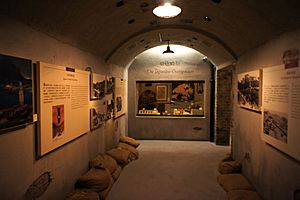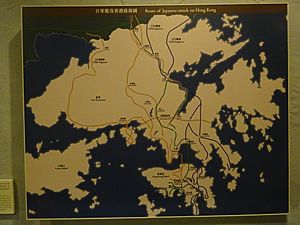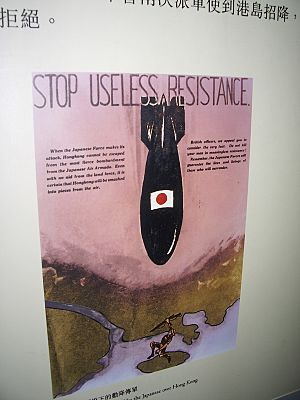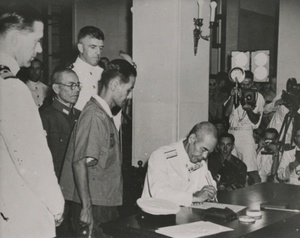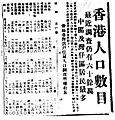Japanese occupation of Hong Kong facts for kids
The Japanese occupation of Hong Kong (also known as 香港日據時期) was a time when Hong Kong was controlled by Japan. This happened during World War II. It started on December 25, 1941, when the British leader of Hong Kong, Sir Mark Young, gave up control to the Japanese army. This was after 18 days of very tough fighting. The Japanese rule lasted for three years and eight months. It ended when Japan surrendered at the end of the war.
Contents
The Battle for Hong Kong
On December 8, 1941, Japan attacked Hong Kong. This was part of their bigger plan to expand in the Pacific Ocean. Soldiers from Britain, Canada, and India tried to stop them. The Hong Kong Volunteer Defense Forces also helped.
However, the Japanese army had many more soldiers. After fierce fighting, the British forces were defeated. On December 25, 1941, Governor Mark Aitchison Young surrendered to the Japanese. For the people of Hong Kong, this day became known as "Black Christmas."
Life Under Japanese Rule
Changes to the Economy
When Japan took over, they controlled all trading. Most factories were taken by the Japanese government. They also took money from banks and businesses. The Hong Kong Dollar was no longer allowed. Instead, people had to use the Japanese Military Yen.
At first, 2 Hong Kong dollars were worth one military yen. But in July 1942, the value changed. Now, 4 Hong Kong dollars were worth one yen. This meant people got less money when they exchanged it. Many people in Hong Kong became very poor. The Japanese government sold the Hong Kong dollars they collected to help pay for their war.
Public transport and services like electricity often stopped working. This was because there wasn't enough fuel. Also, American air raids on Hong Kong caused damage. Many thousands of people lost their homes and jobs. Some worked in shipbuilding or construction. The Japanese even used the race track at Fanling and the air strip at Kam Tin to try growing rice.
Education Changes
The Japanese believed that education was important for spreading their influence. Learning the Japanese language became mandatory. Students who did poorly in Japanese exams could be punished. English was not allowed to be taught or spoken outside of class.
The Japanese government also ran a training course for teachers. Teachers who didn't pass a Japanese language test had to take a three-month training course. The Japanese wanted to teach Hong Kong students about Japanese traditions and customs through these lessons.
The End of the Occupation
The Japanese occupation of Hong Kong ended in 1945. This happened after the United States dropped atomic bombs on two Japanese cities. The first bomb hit Hiroshima on August 6, 1945. Three days later, another bomb was dropped on Nagasaki. On the same day, the USSR attacked the last large Japanese army in China.
Japan finally surrendered on August 15, 1945. On August 30, 1945, the British navy took control of Hong Kong again. This day was called "Liberation Day." It was a public holiday in Hong Kong until 1997.
Hong Kong recovered very quickly after the war. By November 1945, the economy was doing so well that the government removed many controls. Free markets were back. Many people moved back to Hong Kong from China. By early 1946, the population was about one million again.
Images for kids
-
Dongjiang guerillas fighting in trenches
See also
 In Spanish: Ocupación japonesa de Hong Kong para niños
In Spanish: Ocupación japonesa de Hong Kong para niños


